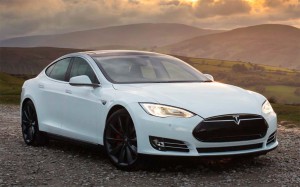Facing an onslaught of new, high-mileage competitors, Tesla Motors is suddenly having to boost its own range to stay competitive. And that includes not only the familiar Model S sedan, but also the upcoming Model X, as well.
Until recently, the top-range version of the long-delayed battery-electric SUV was expected to deliver about 240 miles on a charge. But a quick check of the configurator page reveals that the carmaker has up that number by about 4%, the Tesla Model S now expected to top out at 250 miles using the optional 90-kilowatt-hour battery pack.
But expect to pay dearly for the chance to keep rolling more than halfway from Los Angeles to San Francisco. The P90D, twin-motor version of the new Tesla Model X will start at $132,000. That’s about $5,000 more than a Model S P90D.
Meanwhile, you’ll feel your wallet drain even faster than the ute’s batteries if you drop another $10,000 for the new Ludicrous Speed upgrade. With the Model S, it’s rated at 0 to 60 in just under 3 seconds. The Model X performance model will require 3.2 seconds to hit 60.
The Model X will get its official debut in barely a month, though that comes about two years later than CEO Elon Musk had originally promised. The South African-born executive recently acknowledged that the project was much more of a “challenge” than originally expected. And where Tesla early on hoped to largely lift the majority of parts and components for the ute from the Model S, most will now be unique to the Model X, he confirmed.
Among the new features revealed by the Tesla configurator and other sources, the Model X will be available with a third row. It’s not yet clear if that will be standard or optional.
(Tesla unwrapping Model 3 next spring. For more, Click Here.)
What Model X buyers will get is such features as an air suspension and the new Autopilot software that Musk says will allow hands-free freeway driving, at least in good weather on roads with well-defined lane markers. Tesla is working on a more advanced autonomous system, as well.
What won’t be offered, at least not initially, are the video cameras Tesla had hoped to use in place of conventional sideview mirrors. It has applied for, but not yet received, approval from the National Highway Traffic Safety Administration. Cameras would conceivably reduce aerodynamic drag – improving range while also lowering wind noise. Tesla is just one of many makers hoping to soon adopt that technology.
(Click Here for details how global EV sales hit the 1-million-unit mark.)
While 250 miles might sound like a lot – and it will be about three times the range of most other battery vehicles on the market, save for the Model S – a number of competitors might want to go one better in a push to outdo Tesla.
Just like week, Audi unveiled the e-tron Quattro SUV concept at the Frankfurt Motor Show. Set for production in 2018, Audi claims that battery-ute should deliver about 500 kilometers per charge, or about 310 miles of range.
(To see more about VW and Audi’s plans to “electrify” their entire line-ups, Click Here.)
Tesla, meanwhile, is pushing into more mainstream segments, with plans to start taking orders for its $35,000 Model III starting next spring. But it won’t reach production, Musk noted, for another two years.



“Audi claims that battery-ute should deliver about 500 kilometers per charge, or about 310 miles of range.” Is this estimate based upon the optimistic NEDC? If so, shouldn’t it be derated 20% or so?
What is the difference between the Leaf’s EPA range vs the NEDC to get an idea of the difference.